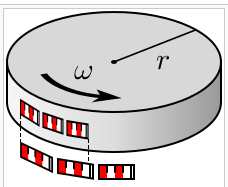According to Einstein it should be greater than $2 \pi R$ for a co-rotating observer, i.e. $L' = \gamma L$ where $L = 2 \pi R$ in a non-rotating frame and $\gamma$ is the usual Lorentz factor, which would make the spatial geometry hyperbolic - from wikipedia:
Imagine a circle drawn about the origin in the x'y' plane of K' and a diameter of this circle. Imagine, further, that we have given a large number of rigid rods, all equal to each other. We suppose these laid in series along the periphery and the diameter of the circle, at rest relatively to K'. If U is the number of these rods along the periphery, D the number along the diameter, then, if K' does not rotate relatively to K, we shall have $U/D=\pi$. But if K' rotates we get a different result. Suppose that at a definite time t, of K we determine the ends of all the rods. With respect to K all the rods upon the periphery experience the Lorentz contraction, but the rods upon the diameter do not experience this contraction (along their lengths!). It therefore follows that $U/D>\pi$.
On the other hand, there's a nice explanation here on SE that I find intuitively appealing but it concludes the opposite: $L' = L/\gamma$.
So which shall it be?
Due to obvious reasons I put more weight on the first possibility, although I don't actually understand the reasoning, so if someone could describe it in more detail it'd be great.
There's also this paper I've been looking at, which arrives at Einstein's result in a general relativistic framework, but I'd rather just stay at measuring rods and the like if it's possible...


